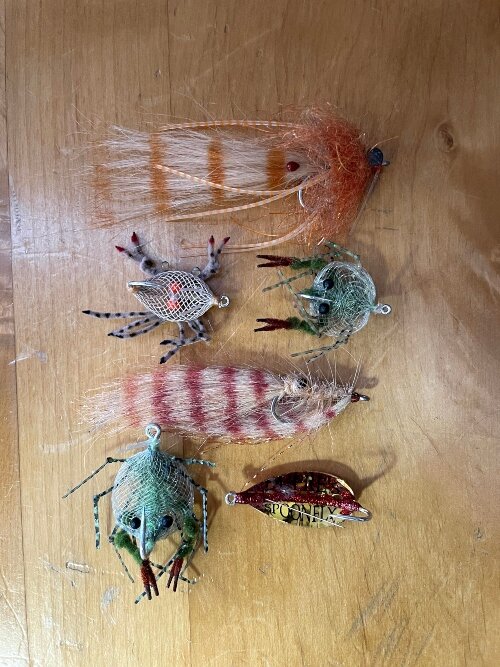How To Choose the Best Redfish Fly
Imagine a scenario where you have a day of redfishing planned. You walk into your local fly shop, head to the saltwater section and start thumbing through the bins. There are some shrimp flies, some crabs, minnow patterns, spoon flies, all of which come in different colors, sizes and prices. It can be extremely overwhelming looking at flies and almost nerve-racking when casting a brand new fly at an actual redfish. Having confidence that the fly you tied on will work takes A LOT of trial and error. So how can you narrow it down when looking at the hundreds if not thousands of options for redfish flies?
First step, relax. A great guide and friend, Tuck Scott, always says “It’s just fishing.” He’s right. It’s just fishing, which is supposed to be fun! So relax, crack open a beer (also fun) and read on as I discuss the top 5 things that make a good redfish fly. (These are all equally important, order is subjective to the angler.)
1) Weight
Redfish are bottom feeders, the large majority of what they eat is on or very near to the bottom of the area you’re fishing. Therefore, your fly needs to have some sort of weight to get it into their feeding zone. Weight is typically added in the form of eyes, lead dumbells or bead chain are the most common ways to beef up the fly but you can also use a thicker gauge hook or even lead wire around the hook shank to get the job done. Simply put, if you’re fishing shallow(6-12 inches), you likely want a lighter fly. Fishing deep or fishing in thick grass, you’ll want a fly with more weight to it. My go to is small lead dumbbell eye fly, I know I can always size up or down depending on how the fish reacts to it.
2) Size
In the trout world you always want to try to “match the hatch” with your fly choice. Saltwater isn’t much different. If redfish are crushing big finger mullet in the summer, you can likely size up your fly to match. If they’re chasing small 1 inch grass shrimp, a fly closer to that size would be recommended. It is also seasonal, a lot of times in the cooler months the bait is smaller and scarcer, so we size down. The opposite is true in the warm months. There are exceptions to everything though. Throwing a larger fly in the cool months can look like a bigger meal and really fire a fish up to eat your fly. Presentation is everything though, if the fish never sees the fly, doesn’t matter what size it is.
3) Color
Color might be the most subjective of these 5 tips because everyone has a favorite color that works for them. You love to see grown men disagreeing over the best color of a rabbit strip. For me, color is completely determined by the water clarity. Dirty water = dark fly. Clear water = light color fly. The darker fly creates a better silhouette in the dirty water and helps it to show up. On the otherhand, if you throw a black fly in crystal clear water, it might show up too well and spook the fish you’re trying to catch. I spend most of the summer and early fall throwing black, purple, dark brown flies and as the water cools down and clears up I’ll switch to tans and natural colors. Flood tides are a little different whereas the water is generally cleaner when it gets to the grass. Here I might throw a green crab fly, or stick to my typical black/purple combo.
4) Type
In the same vein as size, you want to “match the hatch” with your fly type as well. There is a fly for just about every type of bait that a redfish would eat. Figuring out what bait is in the water at a certain time of year can be tricky. Typically, during the warm months there is baitfish, shrimp and crabs. Choosing which pattern to throw depends on the terrain you’re fishing. Flood tide grass flat? Likely a crab fly. Grass edge of a creek? Probably a shrimp fly. Big open water mud flat? Baitfish or shrimp pattern would work well. Keep in mind that a lot of redfish flies look like multiple types of bait so choosing one that best represents the bait in a specific area isn’t as hard as it may sound. Matching the color, size, and weight to that specific bait will help narrow down your options.
5) Weed Guard
Can you catch a redfish on a fly without a weed guard? Absolutely. Do you need a weed guard? Not necessarily, but they’re sure nice to have when you do need them. Stripping a fly through the grass without a weed guard is a lot like skateboarding through a gravel parking lot. You might get from point A to point B, but you’re gonna get stuck more than one time along the way. Having that wire or piece of thick mono/fluoro off the front of your fly keeps that hook bend clear of most debris that wants to grab it. There’s a very slim chance that having a weed guard will deter a redfish from biting the fly. A weed guard does way more good than it does bad.
All of these tips are extremely subjective. Just because it’s written here does not make it the end all be all of redfish flies. Get out there, see what works for you and your fishery! So what’s my favorite fly? Truly it depends on the fishing situation. But 90% of the flies I use are hand tied by myself or from other local tiers from the Lowcountry. Mers Flies and Upcountry Fly Tying to name a couple. All of which are available at Bay Street Outfitters.
Site By: Tucker Deaton



